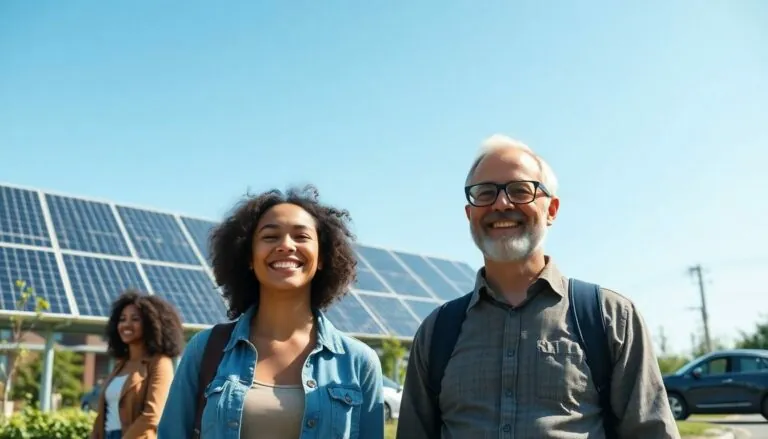The future of energy isn’t just bright—it’s downright electrifying! As the world grapples with climate change and dwindling resources, technology is stepping up like a superhero in a spandex suit. From solar panels that practically dance in the sun to wind turbines that could give a jet engine a run for its money, advancements in technology are paving the way for a sustainable energy revolution.
Table of Contents
ToggleOverview of Sustainable Energy
Sustainable energy focuses on meeting current energy needs while ensuring minimal impact on the environment. It includes renewable sources such as solar, wind, and hydro, aiming to reduce greenhouse gas emissions.
Importance of Sustainability
Sustainability promotes environmental responsibility, allowing future generations to benefit from natural resources. Clean energy sources lower pollution levels, improving public health. Moreover, sustainable practices enhance energy security, reducing reliance on fossil fuels. They also stimulate economic growth through job creation in green technology sectors. Prioritizing sustainability contributes to climate change mitigation and stabilizes energy prices over time.
Current Energy Challenges
Energy systems face several pressing challenges, including reliance on finite fossil fuels. Increased carbon emissions lead to global warming, causing severe weather patterns. Aging infrastructure struggles to meet the demands of a growing population, creating inefficiencies. Energy access remains limited in many regions, hindering development opportunities. Furthermore, rapid technological changes require updates to existing systems, often resulting in significant financial constraints. Addressing these challenges is crucial for advancing towards a sustainable energy future.
Advances in Renewable Energy Technologies
Technology plays a pivotal role in enabling a sustainable energy future. Several advancements in renewable energy models address climate change and resource limitations effectively.
Solar Energy Innovations
Recent innovations in solar technology focus on increasing efficiency and reducing costs. Bifacial solar panels capture sunlight from both sides, enhancing energy output significantly. Additionally, perovskite solar cells promise to improve efficiency levels while lowering production costs. City-wide solar programs facilitate the integration of solar energy into urban infrastructure seamlessly. Smart grid technology also optimizes energy distribution, ensuring solar energy is used efficiently.
Wind Energy Developments
Wind energy technology has progressed through larger and more efficient turbine designs. Offshore wind farms take advantage of stronger and more consistent winds, leading to greater energy yields. Advanced materials reduce the weight of turbine blades, increasing efficiency in energy generation. Digital twinning, a result of Industry 4.0, allows for predictive maintenance and improved turbine performance. Moreover, energy storage solutions complement wind energy, addressing intermittency issues effectively.
Hydropower Enhancements
Enhanced hydropower technologies incorporate small-scale and run-of-river systems, minimizing ecological disruption. Innovations such as fish-friendly turbines promote biodiversity, ensuring wildlife protection. Advanced monitoring systems provide real-time data, allowing operators to optimize performance. Pumped-storage hydropower acts as a reliable energy storage solution, balancing peak demand. Environmental assessments guide the development of hydropower projects, aligning energy generation with sustainability goals.
Smart Grids and Energy Management
Smart grids and energy management systems play a crucial role in transitioning to a sustainable energy future. Enhanced efficiency and reliability characterize these technologies, enabling better integration of renewable energy sources.
Role of Smart Meters
Smart meters track energy consumption in real-time, providing users with detailed insights. These devices promote energy conservation by allowing consumers to monitor usage patterns, leading to more informed decisions. Implementation of smart meters can result in energy savings of up to 15%. Utilities also benefit from accurate data for optimizing energy distribution and managing demand. Enhanced communication between consumers and utilities fosters engagement in energy management programs.
Demand Response Technologies
Demand response technologies enable consumers and businesses to adjust energy usage based on supply availability. Increased responsiveness through these technologies reduces peak demand and overall energy consumption. Participating in demand response programs can lead to financial incentives for customers while stabilizing the grid. Implementing these solutions mitigates the need for additional fossil-fuel power plants, significantly lowering carbon emissions. Real-time communication between utilities and users ensures a more resilient and sustainable energy system.
Energy Storage Solutions
Energy storage solutions play a critical role in the transition to a sustainable energy future. These technologies enhance the reliability of renewable energy sources, making them more viable and efficient.
Battery Technology Improvements
Lithium-ion batteries dominate the market, but ongoing advancements are enhancing their efficiency and affordability. Improved energy density in these batteries allows for longer usage times between charges. Solid-state batteries are emerging as a safer and more efficient alternative, featuring higher energy capacities and reduced fire risks. Innovations such as battery recycling processes are also gaining traction, aiming to minimize waste and support sustainable practices. High-performance materials and faster charging capabilities contribute to the growing appeal of battery technologies in various applications, from electric vehicles to large-scale energy storage systems.
Emerging Storage Options
Pumped hydro storage remains the leading large-scale technology, utilizing excess energy to lift water and release it for electricity generation during peak demand. Emerging alternatives include compressed air energy storage, using surplus energy to compress air in underground chambers, which releases power through turbines when needed. Flywheel energy storage systems store kinetic energy and provide rapid response times, making them ideal for stabilizing grid performance. Moreover, advancements in thermal energy storage systems allow for the use of heat generated from renewable sources to produce electricity when required. Each of these innovative storage options enhances the capacity to harness renewable energy, further driving sustainability.
Role of Artificial Intelligence
Artificial Intelligence (AI) plays a significant role in transitioning to a sustainable energy future by optimizing various processes. It enhances efficiency, reduces waste, and informs decision-making across energy systems.
AI in Energy Efficiency
AI drives energy efficiency by analyzing vast amounts of operational data. This technology optimizes energy usage patterns in buildings, resulting in energy conservation. Additionally, AI systems can automate lighting and heating systems, adjusting settings based on occupancy and weather conditions. Organizations implementing AI-driven solutions often report energy savings of 10% to 30%, significantly lowering operational costs.
Predictive Analytics for Energy Management
Predictive analytics powered by AI enables effective energy management. These tools forecast energy demand by examining historical consumption data and identifying patterns. Utilities leverage predictive analytics to optimize power generation and grid integration, effectively balancing supply and demand. In many cases, this technology can achieve a 20% reduction in overall energy consumption during peak hours, thereby enhancing grid stability and boosting the use of renewable energy sources.
Policy and Regulation Impacts
Policies and regulations play a vital role in fostering advancements toward a sustainable energy future. Governments establish frameworks that encourage technology adoption and sustainability efforts.
Government Incentives for Technology Adoption
Incentives drive the adoption of clean energy technologies. Financial motivations, such as tax credits and grants, lower barriers for companies investing in solar and wind energy. These programs can enhance return on investment, leading to increased deployment of renewable energy sources. Federal and state governments often collaborate, amplifying the impact of policies through combined efforts. Furthermore, streamlined permitting processes expedite project development, enabling quicker transitions to sustainable solutions.
International Cooperation on Sustainability
Cooperation among nations addresses global energy challenges effectively. International agreements, like the Paris Agreement, set crucial emissions reduction targets and unify countries in their pursuit of sustainability. These collaborations facilitate knowledge sharing and technology transfer, allowing developing nations to access advanced energy solutions. Multinational frameworks also enable pooling of resources to support research and development in renewable technologies. Collective action reinforces accountability, ensuring countries remain committed to their sustainability goals.
The transition to a sustainable energy future hinges on the integration of advanced technologies that enhance efficiency and reduce environmental impact. Innovations in renewable energy sources like solar and wind, along with smart grid systems and energy storage solutions, play a pivotal role in this transformation. Artificial Intelligence further optimizes energy management and consumption patterns, driving significant savings and stability within the grid.
Supporting policies and international collaboration are essential to propel these advancements forward. As societies embrace these technologies and practices, they not only address current energy challenges but also pave the way for a cleaner, more sustainable world. The combined efforts in technology, policy, and community engagement will ultimately define the success of this critical transition.



